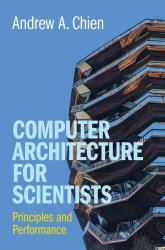Computer Architecture for Scientists: Principles and Performance
- Добавил: literator
- Дата: 12-12-2023, 21:34
- Комментариев: 0
 Название: Computer Architecture for Scientists: Principles and Performance
Название: Computer Architecture for Scientists: Principles and PerformanceАвтор: Andrew A. Chien
Издательство: Cambridge University Press
Год: 2022
Страниц: 266
Язык: английский
Формат: pdf (true)
Размер: 10.2 MB
Because of computing’s history, the pedagogy of computer architecture has been aimed at future computer designers and engineers. However, a growing number of data scientists, engineers who are not computer engineers, and even the majority of computer scientists (i.e. artificial intelligence and more) see computing as an intellectual tool. These scientists and engineers need an understanding of computer architecture for insights into how hardware enables, shapes, and limits performance. They need an understanding of computer architecture that allows them to reason about performance today and scaling into the future. It is for them that I have undertaken this book.
Computer architecture is the science and engineering that underpins the design of computer hardware. It is both the design of the software–hardware interface that defines portability and correct execution for software, and also the organizational understanding for hardware that effectively exploits advancing microelectronics technology for increased computing performance. For this reason, computer organization is another term used for computer architecture.
The dramatic increase in computer performance has been extraordinary, but not for all computations: it has key limits and structure. Software architects, developers, and even data scientists need to understand how exploit the fundamental structure of computer performance to harness it for future applications. Ideal for upper level undergraduates, Computer Architecture for Scientists covers four key pillars of computer performance and imparts a high-level basis for reasoning with and understanding these concepts: Small is fast – how size scaling drives performance; Implicit parallelism – how a sequential program can be executed faster with parallelism; Dynamic locality – skirting physical limits, by arranging data in a smaller space; Parallelism – increasing performance with teams of workers. These principles and models provide approachable high-level insights and quantitative modelling without distracting low-level detail. Finally, the text covers the GPU and Machine Learning accelerators that have become increasingly important for mainstream applications.
For these data science, artificial intelligence, and applied machine learning students, a foundation in computer architecture should provide scientific understanding of how the remarkable power of computing is possible, and what limits that power – and, as we look forward to the future, how the continued progress in technology will increase computing capabilities. This book provides such a principles-based ground-ing in the current and future capabilities of computing hardware.
Скачать Computer Architecture for Scientists: Principles and Performance
Внимание
Уважаемый посетитель, Вы зашли на сайт как незарегистрированный пользователь.
Мы рекомендуем Вам зарегистрироваться либо войти на сайт под своим именем.
Уважаемый посетитель, Вы зашли на сайт как незарегистрированный пользователь.
Мы рекомендуем Вам зарегистрироваться либо войти на сайт под своим именем.
Информация
Посетители, находящиеся в группе Гости, не могут оставлять комментарии к данной публикации.
Посетители, находящиеся в группе Гости, не могут оставлять комментарии к данной публикации.
